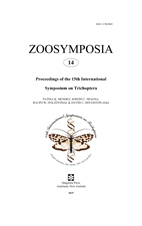Abstract
To clarify the effect of the visible spectrum, we collected Trichoptera adults using blue, green, and white light-emitting diode (LED) lamps and black light (BL) lamps. Except for white LED lamps, all lamps emitted broad-band wavelengths in the ultraviolet spectrum. A total of 212 adult Trichoptera were trapped. The most individuals were attracted by BL (96), followed blue (74), green (32), and white (10). Hydroptilidae spp. was the most abundant taxa among the lamps (183 individuals, 86.3%), followed by Cheumatopsyche brevilineata (23 individuals, 10.8%). Only Hydroptilidae spp. was common to all lamps. The Shannon–Wiener diversity index (H’) was highest at 0.96 for BL, followed by green (0.53), and blue (0.28). Trichoptera were attracted to both UV light and visible light. These results suggest that BL is the most useful for faunistic investigations of Trichoptera.

